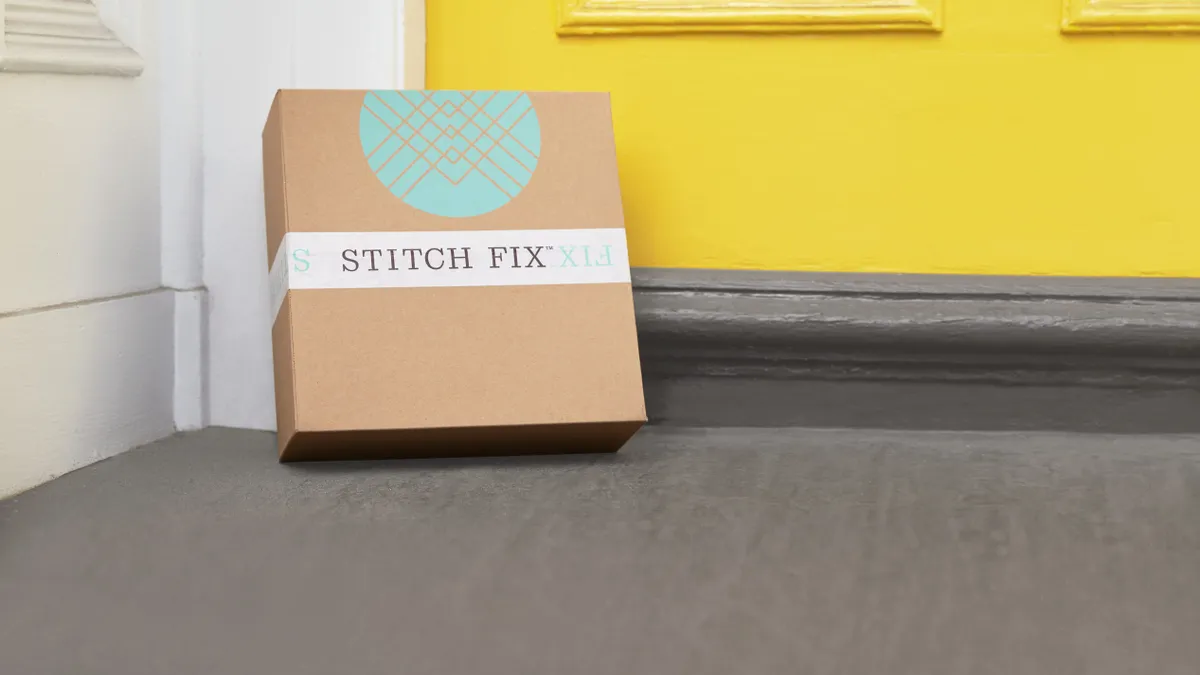Dive Brief:
-
Stitch Fix on Tuesday said that net revenue in the first quarter of its fiscal year fell 21.6% to $455.6 million. Net loss ballooned by nearly 3,000% to $55.9 million, its worst Q1 performance since the company began reporting its results, according to GlobalData.
-
The company lost more than 470,000 active clients, an 11.3% decline to 3.7 million. Net revenue per active client, (anyone who ordered a curated box or bought directly from its site in the preceding 52 weeks), was flat. Gross margin declined 490 basis points due to higher costs and deeper discounts. Inventory rose 20% year over year, Chief Financial Officer Dan Jedda told analysts on a conference call.
-
The apparel e-retailer said it lowered its sales guidance for the full year, expecting revenue to land between $1.6 billion and $1.7 billion, down from between $1.8 billion and $1.9 billion.
Dive Insight:
Stitch Fix has tweaked its model more than once in recent months, opening its direct-buy Freestyle site to all shoppers in September 2021, then limiting it again to its box customers a year later. But any improvements from such changes are getting clouded by outside pressures. Inflation’s toll on household discretionary spending appears to be affecting nearly all Stitch Fix customers, according to Jedda. Plus, Stitch Fix is facing stiffer competition from the rising discounts on apparel seen across the sector.
“Our analysis does show that clients are spending less across a broad set of cohorts and we expect this to continue given the economic backdrop and the deep discounting we are seeing in the retail industry,” he said, adding, “We looked at this in many different ways across our cohorts.”
For several quarters straight, the company has lost customers and losses have widened. Now, the bottom line is in focus. To help achieve profitability, Stitch Fix will trim expenses, including significantly reducing its marketing spend, executives told analysts Tuesday. That experiment is risky, according to some analysts, including those at William Blair led by Dylan Carden.
“Watch this space,” he said in emailed comments. “We commend the effort here, but caution about the likely volatility ahead. Sales and marketing are intrinsically linked for any apparel retailer, running at a correlation of 0.79 on a trailing 12-month basis for Stitch Fix.”
This also could have implications for e-commerce more widely, according to Carden. Pure-play e-retailers are twice as likely as brick-and-mortar retailers to be unprofitable, and nearly twice as likely to say they are struggling to make the investments necessary to improve profitability, according to Ipsos research. Even Amazon in recent months has stepped up efforts to rein in costs, through hiring freezes, layoffs and a review of its operations, much of that in retail.
“Stitch Fix is ripping the Band-Aid off of a touchy subject in the digitally native brand world, cutting marketing to drive profitability,” Carden said. “The ramifications for sales should be closely watched, as we believe many companies with higher marketing budgets (and there are several with double the relative spend of Stitch Fix) are facing a similar choice.”
The company employs algorithms and human stylists to curate boxes for customers, a setup that CEO Elizabeth Spaulding reiterated is a powerful differentiator. But the box approach has been abandoned by other companies, including Nordstrom and ThredUp, and Wells Fargo analysts warned that it remains unproven at Stitch Fix.
“[W]ith the company continuing to see active members declines and now delaying its guided inflection back to growth, we see the name remaining particularly challenged,” Wells Fargo analysts said in emailed comments. "In our view, the business model is in question.”













